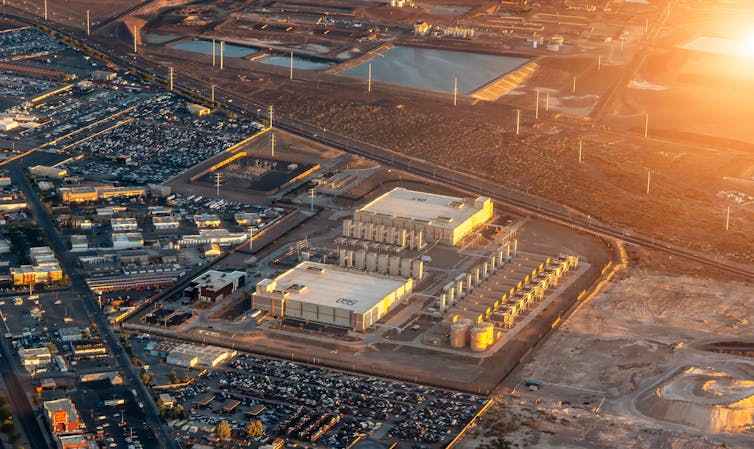Trump is attracting investment to the US – but at a huge cost to workers and the environment
- Written by Benjamin Selwyn, Professor of International Relations and International Development, Department of International Relations, University of Sussex

Early in his second presidency, Donald Trump’s imposition of tariffs was met with widespread scepticism. Critics warned of economic decline and a global backlash. Yet the current landscape for the United States paints a more complex picture.
Less than a year into his second term in office[1], the White House claims that Trump is bringing manufacturing back[2] to the US. It also proclaims that Trump has secured trillions of dollars of foreign direct investment (FDI) in 2025 alone[3]. Other voices, however, estimate that these commitments will amount to just a fraction of that[4].
So what’s the true picture? Much of this FDI is going into the US’s burgeoning semiconductor sector[5]. This inward investment is indeed a stark reversal from the post-1991 trend of outbound American capital, when US firms raced to set up factories in countries where it was cheaper to manufacture.
And the surge is bolstered by commitments of US$300 billion (£225 billion) in capital investment commitments from tech giants[6] like Amazon, Microsoft, Alphabet and Meta. These investments reflect both Trump’s aggressive diplomacy and his close relationship with Silicon Valley’s tech elite.
Despite concerns about a tech bubble[7], these investments signal a deepening state-private partnership, and a reorientation of priorities with a view to coming out on top in the global AI race.
Central to this strategy is the reshaping of global supply chains. At a conference of venture capitalists in March, US vice-president J.D. Vance criticised[8] US firms for their reliance on cheap overseas labour. He warned of the risks of losing the US’s technological advantage, especially to China.
The solution, Vance and Trump argue, is to bring investments and jobs back home. But does this logic – backed by massive domestic and foreign investment – translate into the kind of reshoring (when operations that were previously moved abroad transfer back to the country) that delivers good jobs?
In our new book[9] Capitalist Value Chains, Christin Bernhold and I argue that global supply chains have made labour exploitation and environmental degradation worse[10]. Efforts by both former president Joe Biden and Trump to contain China’s rise reflect not a retreat from globalisation, but a strategic reconfiguration of supply chains.
In the early days of globalisation, American administrations supported China’s rise as the workshop of the world and an exporter of low-cost consumer goods to the US. But over the last 15 years, the US has increased efforts to contain China’s technological rise, while continuing to rely on its cheap imports.
Trump’s tariffs on China represent a step change. The US’s strategy now seems to have shifted from slowing China’s advance to attempts to inflict severe economic damage on the Chinese economy in order to reduce it[11] to a subordinate, rather than rival, trading partner.
So will these investments create quality employment? And what are the environmental consequences? The likely answers are probably not, and probably terrible.
Reshoring doesn’t mean abandoning global supply chains. Recently, Trump threatened sweeping tariffs on China in response to its restrictions on rare earth exports. Western industries – especially automotive and defence – warned that this escalation could break supply chains[12]. US chip-dependent sectors such as electronics, defence and telecoms still rely heavily on Chinese rare earths.
Even if the US succeeds in reshaping supply chains, it doesn’t guarantee the creation of good jobs. Despite Trump’s pro-labour rhetoric, his administration’s actions tell a different story.
In March 2025, Elon Musk’s Department of Government Efficiency laid off 216,000 federal workers[13]. Collective bargaining rights were stripped from 400,000 employees[14] across agencies like Veterans Affairs, the Environmental Protection Agency and the Transportation Security Administration. The White House also revoked the US$15 per hour minimum wage requirement for publicly-funded businesses[15].
Traditional sectors are suffering. Since April, machinery giant John Deere has cut more than 2,000 jobs, citing cost increases blamed on Trump’s tariffs. The big three carmakers – Ford, GM and Stellantis – claim that tariffs will cost them US$7 billion in lost earnings in 2025, with severe consequences for pay and jobs.[16][17]
Will the tech sector’s massive capital spends offset these losses? Most of the US$300 billion pledged by firms like Apple and Amazon is earmarked for AI infrastructure: high-powered data centres, custom chips, graphics processing units and cloud networks.
These are capital-intensive projects[18] that generate short-term construction jobs but offer little[19] in the way of long-term employment.
Simultaneously, tech companies are downsizing as they substitute AI for human labour[20]. Microsoft announced layoffs[21] of 6,000 and 9,000 employees from its 228,000-strong global labour force in May and July 2025, including 800 in Washington, Microsoft’s home state.
And what about the quality of the remaining jobs? At Amazon[22], for example, the company’s software engineers have described how it is using AI to cut jobs and speed up work. According to reports, tasks that previously took weeks are now expected to be completed in days. One engineer told journalists that his team was halved in size, but is expected to produce the same amount of code, using AI tools.
The environmental costs of AI are mounting. Researchers have found that data centres already consume 4.4% of the US’s electricity[23]. By 2028, AI could require as much power as 22% of American households[24] use annually.
This surge in demand, combined with federal budget cuts to green energy initiatives, is diverting renewable energy away from broader decarbonisation efforts[26] such as hydrogen tech projects, battery plants and upgrades to the electric grid.
These figures are only set to rise if the surge continues. According to the International Energy Agency, fossil fuels – particularly coal and natural gas – are expected to supply more than 40%[27] of the additional electricity needed by data centres until 2030.
Trump’s push towards AI, coupled with his tariff regime and alliance with Silicon Valley’s elite, may reshape the economy and global supply chains – but not in favour of workers or the planet. The promise of revitalised manufacturing and job creation masks deeper risks: automation, weakened labour protections and escalating environmental harm.
References
- ^ second term in office (theconversation.com)
- ^ bringing manufacturing back (www.whitehouse.gov)
- ^ in 2025 alone (edition.cnn.com)
- ^ just a fraction of that (www.ft.com)
- ^ burgeoning semiconductor sector (www.fdiintelligence.com)
- ^ tech giants (www.ft.com)
- ^ a tech bubble (theconversation.com)
- ^ J.D. Vance criticised (www.americanrhetoric.com)
- ^ our new book (global.oup.com)
- ^ environmental degradation worse (www.tandfonline.com)
- ^ reduce it (academic.oup.com)
- ^ break supply chains (www.ft.com)
- ^ 216,000 federal workers (www.cbsnews.com)
- ^ 400,000 employees (www.theguardian.com)
- ^ publicly-funded businesses (www.newamerica.org)
- ^ cost increases (www.commondreams.org)
- ^ pay and jobs. (www.ft.com)
- ^ capital-intensive projects (lucidityinsights.com)
- ^ offer little (www.datacenterknowledge.com)
- ^ AI for human labour (tech.co)
- ^ Microsoft announced layoffs (www.bbc.co.uk)
- ^ At Amazon (www.nytimes.com)
- ^ 4.4% of the US’s electricity (www.congress.gov)
- ^ 22% of American households (www.technologyreview.com)
- ^ Audio und werbung/Shutterstock (www.shutterstock.com)
- ^ broader decarbonisation efforts (www.pbs.org)
- ^ more than 40% (www.iea.org)







